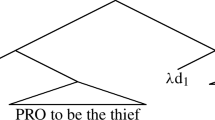Abstract
In this paper, I provide a compositional semantics for sentences with enough and too followed by a to-infinitive clause and for resultative constructions with so... that within the framework of possible world semantics. It is proposed that the sentential complement of these constructions denotes an incomplete conditional and is explicitly or implicitly modalized, as if it were the consequent of a complete conditional. Enough, too, and so are quantifiers that relate an extent predicate and the incomplete conditional (expressed by the sentential complement) and are interpreted as comparisons between two extents. The first extent is the maximal extent that satisfies the extent predicate. The second extent is the minimal or maximal extent of a set of extents that satisfy the (hidden) conditional, where the sentential complement supplies the consequent and the main clause the antecedent. This approach permits to predict (a) the context-dependent interpretation of these constructions and (b) the duality relations between the degree words.
Similar content being viewed by others
References
Abney, S.: 1983, The English Noun Phrase and Its Sentential Aspects, PhD dissertation, MIT.
Beck, S.: 1996, Wh-Constructions and Transparent Logical Form, PhD dissertation, Universität Tübingen.
Bierwisch, M.: 1987, ‘Semantik der Graduierung’, in M. Bierwisch and E. Lang (eds.), Grammatische und konzeptuelle Aspekte von Dimensionsadjektiven (Studia Grammatica, Vol. 16), pp. 91–286. Akademie-Verlag, Berlin.
Bresnan, J. W.: 1973, ‘Syntax of the Comparative Clause Construction in English’, Linguistic Inquiry 4, 275–343.
Corver, N.: 1990, The Syntax of the Left Branch Constraint, PhD dissertation, Tilburg University.
Cresswell, M. J.: 1976, ‘The Semantics of Degrees’, in B. Partee (ed.), Montague Grammar, pp. 261–292. Academic Press, New York.
Gallin, D.: 1975, Intensional and Higher Order Modal Logic with Applications to Montague Semantics. North-Holland, Amsterdam.
Guéron, J. and R. May: 1984, ‘Extraposition and Logical Form’, Linguistic Inquiry 15(1), 1–31.
Heim, I.: 1985, ‘Notes on Comparatives and Related Matters’, ms., MIT.
Heim, I.: 2000, ‘Degree Operators and Scope’, in B. Jackson and T. Matthews (eds.), Proceedings of SALT 10, CLC Publications, Cornell University, Ithaca, N.Y.
Heim, I. and A. Kratzer: 1991, ‘Introduction to Formal Semantics’. ms., MIT and University of Massachusetts at Amherst.
Heim, I. and A. Kratzer: 1998, Semantics in Generative Grammar, Blackwell, Malden, Mass.
Hellan, L.: 1981, Towards an Integrated Analysis of Comparatives. Narr, Tübingen.
Iatridou, S.: 1991, Topics in Conditionals, PhD dissertation, MIT.
Karttunen, L.: 1971, ‘Implicative Verbs’, Language 47(2), 340–358.
Kayne, R.: 1984, Connectedness and Binary Branching. Foris, Dordrecht.
Kennedy, C.: 2001, ‘Polar Opposition and the Ontology of Degrees’, Linguistics & Philosophy 24(1), 33–70.
Kennedy, C.: 1999, Projecting the Adjective. The Syntax and Semantics of Gradability and Comparison (Outstanding Dissertations in Linguistics). Garland Publishing, New York.
Kratzer, A.: 1978, Semantik der Rede: Kontexttheorie, Modalwörter, Konditionalsätze. Scriptor, Königstein.
Kratzer, A.: 1981, ‘The Notional Category of Modality’, in H. J. Eikmeyer and H. Rieser (eds.), Words, Worlds and Contexts: New Approaches in Word Semantics, pp. 38–74. De Gruyter, Berlin.
Kratzer, A.: 1991, ‘Modality’, in A. von Stechow and D. Wunderlich (eds.), Semantik: Ein internationales Handbuch zeitgenössischer Forschung, pp. 639–650. De Gruyter, Berlin.
Lewis, D.: 1968, ‘Counterpart Theory and Quantified Logic’, Journal of Philosophy 68, 203–211.
Lewis, D.: 1973, Counterfactuals. Blackwell, Oxford.
Liberman, M.: 1974, ‘On Conditioning the Rule of Subj.-Aux.-Inversion’, in J. Hankamer (ed.), Papers from the Fifth Annual Conference of the North Eastern Linguistics Society, pp. 77–91. Harvard University, Cambridge, Mass.
Löbner, S.: 1990, Wahr neben Falsch. Linguistische Arbeiten, Vol. 244. Niemeyer, Tübingen.
Meier, C.: 2000, Konsekutive Konstruktionen und relative Modalität, PhD dissertation, Universität Tübingen.
Müller, G.: 1993, On Deriving Movement Type Asymmetries, PhD dissertation, Universität Tübingen.
Partee, B.: 1991, ‘Topic, Focus and Quantification’, in S. Moore and A. Wyner (eds.), Proceedings of SALT 1, pp. 159–187.
Rouveret, A.: 1978, ‘Result Clauses and Conditions on Rules’, in S. Keyser (ed.), Recent Transformational Studies in European Languages, pp. 159–178. MIT Press, Cambridge, Mass.
Schwarzschild, R. and K. Wilkinson: 2002, ‘Quantifiers in Comparatives: A Semantics of Degrees Based on Intervals’, Natural Language Semantics 10, 1–41.
Seuren, P. A.: 1984, ‘The Comparative Revisited’, Journal of Semantics 3, 109–141.
von Stechow, A.: 1984a, ‘Comparing Semantic Theories of Comparison’, Journal of Semantics 3, 1–77.
von Stechow, A.: 1984b, ‘My Reaction to Cresswell’s, Hellan's, Hoeksema's and Seuren's Comments', Journal of Semantics 3, 183–199.
von Stechow, A.: 1993, ‘Die Aufgaben der Syntax’, in J. Jacobs, A. von Stechow, W. Sternefeld, and T. Vennemann (eds.), Syntax: Ein internationales Handbuch zeitgenössischer Forschung, Vol. 9.1, pp. 1–88. De Gruyter, Berlin.
Author information
Authors and Affiliations
Rights and permissions
About this article
Cite this article
Meier, C. The Meaning of Too, Enough, and So... That . Natural Language Semantics 11, 69–107 (2003). https://doi.org/10.1023/A:1023002608785
Issue Date:
DOI: https://doi.org/10.1023/A:1023002608785




